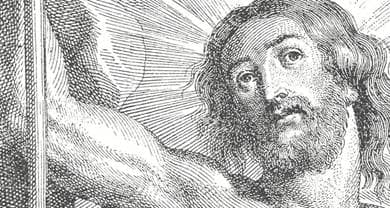- Trending:
- Easter
- |
- Lent
- |
- Forgiveness
- |
- Resurrection
- |
- Joy
- |
- Feminism

RELIGION LIBRARY
Anglican/Episcopalian
Symbolism
The most visible symbol in Anglicanism, and indeed in Christianity generally, is the cross. The cross represents the sacrifice of Jesus Christ for the forgiveness of human sin, and by correlation represents faith (Christ is the object of our faith), hope (for salvation), and love (God's love, which brought Christ to the cross). It also represents the burden that the Christian must bear in following Jesus. All of Christianity is summed up in the cross.
In Anglican symbolism the cross is sometimes shown with the crucified Christ still on it, in which case it is known as a "crucifix." More often the cross is empty, symbolic of the resurrection. Crosses may be simple or ornate, worn as jewelry or displayed in the home. They are also common in Anglican worship spaces, and the rite of baptism is concluded by the priest's marking (with his or her hand) the sign of the cross on the head of the person baptized.
It was not always so. The sign of the cross was once a matter of conflict in Anglicanism. In the late 16th and early-to-mid 17th centuries some Puritans in the Church of England believed the Church had not gone far enough in ridding itself of the vestiges of Roman religion, and they sought to rid the Church of all images, including crosses. One point of great conflict was the making of the sign of the cross in baptism, which some Protestants viewed as implying some sort of supernatural power inherent in the making of the sign.
This iconoclastic impulse was applied more broadly to images other than the cross early in Anglican history. Images connected with pilgrimages and the cult of purgatory--both of which implied papal authority--were smashed during the reigns of Henry VIII and his son, Edward VI. During the reigns of Elizabeth I and James I, Anglican worship spaces were, with notable exceptions such as the Chapel Royal under Elizabeth (and the broader exception of formal clerical vestments), relatively lacking in symbolic ornamentation. Anglicanism roughly followed the Protestant view that icons and images were futile distractions from the saving message of salvation through God's grace alone. Other than brief periods of ornamental revival, this remained the case through much of Anglican history until the mid-19th century. At that time the rise of Anglo-Catholicism exercised a great influence on many church interiors, and symbolic materials became more popular in Anglican worship spaces.
Today, some Anglican cathedrals and parish churches with strong Anglo-Catholic inclinations might be said to resemble a Roman Catholic space. Others of Evangelical bent may be as austere as that of a Reformed church. Many, however, fall between these extremes. Images of saints are rare in Anglican churches, and in many cases where they are found the purpose is merely to honor the saint's memory, much like a picture of Abraham Lincoln on the wall of a school honors his memory.
Candles, on the other hand, are commonly used in Anglican worship, symbolizing Christ as the light of humankind. Altars may be draped in white linen, symbolizing Christ's purity. In many churches, the colors of the paraments are changed according to the liturgical season: purple for Advent and Lent (sometimes blue for Advent), white for Christmas and Easter, green for the ordinary periods after Epiphany and Pentecost, red for Holy Week and the day of Pentecost, and black for Good Friday. Some churches display stylized images of Greek letters such as chi and rho, the first two letters in the word "Christ," or alpha and omega, symbolizing God as the beginning and end, the foundation and culmination of all things.
Another depiction that has become more common in Anglicanism because of Anglo-Catholicism is of the stations of the cross. These are typically fourteen stages of Christ's suffering and death that have been traditionally recognized as distinct for devotional purposes. These may be depicted in stained glass, or carvings, or in temporary décor (or just verbally) for Good Friday worship services.
An additional impact of Anglo-Catholicism has been the popularity of formal clerical vestments in worship, which had long been out of favor in Anglicanism. Most vestments are simply vestiges of ordinary garments used in ancient times, such as robes. But symbolic meaning has been attached to them for centuries. For instance, clergy might wear a white linen robe, signifying purity. Other items indicate rank, such as a miter (a type of hat) for a bishop. Bishops also may have a crosier, a bent staff indicating his or her role as shepherd.
The popularity of formal vestments has waned in recent decades, however. Clergy might wear a simple clerical shirt and collar in order to indicate his or her status (not to say higher status) as a clergy person. Some might even wear street clothes (commonly along the lines of so-called "business casual"), indicating equality with the parishioners. This approach has been criticized, however, as indicating equality with the mainstream, but not with the downtrodden.
Another symbol accepted by many Anglicans--and indeed most Christians--is the fish. The Greek word for fish (ichthus) fits as an acronym for "Jesus Christ, Son of God, Savior" in Greek. Jesus also called the fishermen Andrew and Simon (Peter) to follow him so that they could be "fishers of men." The dove is also an accepted symbol for the Holy Spirit--this is particularly popular among those Anglicans influenced by the Charismatic renewal movement.
Study Questions:
1. Why is the cross the most visible symbol of Anglicanism? How is it represented?
2. What is role of imagery within the Anglican Church?
3. Why do many Anglican Churches use candles within worship?
4. What symbolic meaning do clergy vestments hold?
5. Why is the fish often used to symbolize Christianity?










